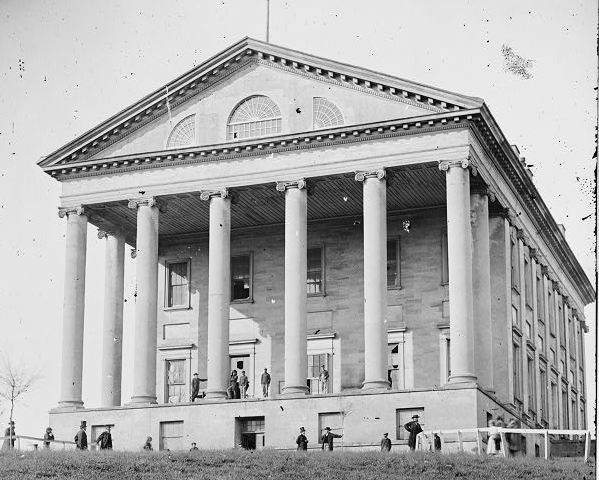
the Capitol in Richmond, when used for the Confederate Congress in 1861-65, had steps on either side but not on the South portico
Source: Library of Congress, Richmond, Va. Front view of Capitol

the Capitol in Richmond, when used for the Confederate Congress in 1861-65, had steps on either side but not on the South portico
Source: Library of Congress, Richmond, Va. Front view of Capitol
In 1860-1861, 11 southern states attempted to withdraw completely from the United States of America and form the Confederate States of America. For four years, those states claimed they were governed under the constitution of the Confederate States of America.
Secession was based on the fears expressed by Patrick Henry in 1788, that an excessively-strong central government could constrain the powers of individual states. The primary state's right threatened in 1861 was the power of southern states to protect what slaveowners called "private property."
Virginia waited until war erupted and President Lincoln issued a call on April 15, 1861 for the state to provide 3,500 militia troops that potentially could invade the seven states which had seceded before the seizure of Fort Sumter. In a 76-19 vote on April 25, 1861, the Secession Convention in Virginia ratified the March 11, 1861 version of the Constitution of the Provisional Government of the Confederate States of America.
Like the US Constitution in 1788, the Confederate Constitution was approved by a convention with elected delegates, but it was never submitted to all of Virginia's voters for ratification. The adoption of the new constitution uniting Virginia with the Confederate States of America was approved only by the delegates to the Secession Convention.
Voters across the state approved the Ordinance of Secession on May 23, 1861, but that vote did not include ratification of the Confederate constitution. Instead, the secession ordinance revoked ratification of the Constitution of the United States of America, as adopted by Virginia on June 25, 1788, by declaring:1
Virginians split over the legitimacy of that claim. Those in the western third of the state met in the First Wheeling Convention on May 13-15, 1861, and asserted that secession and the Confederate constitution were not valid in Virginia. The legal basis for the creation of the state of West Virginia is that the US Constitution stayed in effect throughout the Civil War.2
Under the US Constitution, the "Restored Government of Virginia" could agree to the division of the state. The US Congress based its authority to approve the split on Article IV, section 3. The same language was included in the constitution adopted by the Confederate States of America:3
The Provisional Congress of the Confederacy started meeting in the Virginia State Capitol on July 20, 1861. Rooms were modified to allow both the Virginia and Confederate legislatures to share the building until the last session of the Confederate Congress on March 18, 1865. The military defeat of the Confederacy ended the claim that the Confederate Constitution had legitmacy in Virginia.4
1. "Patrick Henry," in "Liberty: The American Revolution," Public Broadcasting System, 2004, http://www.pbs.org/ktca/liberty/popup_henry.html; "Virginia’s Moment," New York Times, April 17, 2011, https://opinionator.blogs.nytimes.com/2011/04/17/virginias-moment/; "Tenth Day of Secret Session," Virginia Secession Convention, University of Richmond, https://secession.richmond.edu/documents/index.html?keyword=ratify+constitution&element=p&formType=Keyword&start=1&order=date&direction=ascending&id=pb.4.506; "Virginia Ordinance of Secession - April 17, 1861," A State of Convenience - The Creation of the State of West Virginia, West Virginia Archives and History, http://www.wvculture.org/history/statehood/ordinanceofsecession.html (last checked May 11, 2019)
2. "First Wheeling Convention," A State on Convenience - The Creation of the State of West Virginia," West Virginia Archives and History, http://www.wvculture.org/history/statehood/statehood05.html (last checked May 12, 2019)
3. "Constitution of the United States," US Senate, http://www.senate.gov/civics/constitution_item/constitution.htm; "Constitution of the Confederate States; March 11, 1861," Avalon Project, Yale Law School, http://avalon.law.yale.edu/19th_century/csa_csa.asp (last checked May 11, 2019)
4. Mark K. Greenough, "The Virginia State Capitol during the Civil War," Encyclopedia Virginia, Virginia Foundation for the Humanities, October 27, 2015, https://www.encyclopediavirginia.org/Virginia_State_Capitol_During_the_Civil_War_The (last checked May 12, 2019)